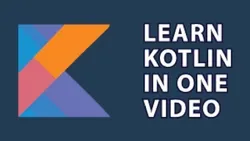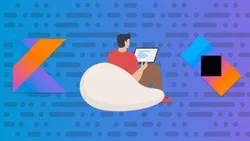
Kotlin Tutorial 
This tutorial provides an introduction to the Kotlin programming language, covering installation on MacOS and Windows, data types, casting, strings, arrays, ranges, conditionals, functions, higher order functions, collection operators, and exception handling. It is a comprehensive guide for those looking to learn the basics of Kotlin. ▼
ADVERTISEMENT
Course Feature
![]() Cost:
Cost:
Free
![]() Provider:
Provider:
Youtube
![]() Certificate:
Certificate:
Paid Certification
![]() Language:
Language:
English
![]() Start Date:
Start Date:
On-Demand
Course Overview
❗The content presented here is sourced directly from Youtube platform. For comprehensive course details, including enrollment information, simply click on the 'Go to class' link on our website.
Updated in [February 21st, 2023]
1. MacOS Install: Learners can obtain the knowledge of how to install Kotlin on MacOS. They can learn the steps to install the software and the necessary components needed for the installation.
2. Windows Install: Learners can obtain the knowledge of how to install Kotlin on Windows. They can learn the steps to install the software and the necessary components needed for the installation.
3. Data Types: Learners can obtain the knowledge of the different data types available in Kotlin. They can learn about the different types of data and how to use them in their code.
4. Casting: Learners can obtain the knowledge of how to cast data types in Kotlin. They can learn how to convert one data type to another and how to use the casting functions available in Kotlin.
5. Strings: Learners can obtain the knowledge of how to work with strings in Kotlin. They can learn how to create strings, manipulate strings, and use the string functions available in Kotlin.
6. Arrays: Learners can obtain the knowledge of how to work with arrays in Kotlin. They can learn how to create arrays, manipulate arrays, and use the array functions available in Kotlin.
7. Ranges: Learners can obtain the knowledge of how to work with ranges in Kotlin. They can learn how to create ranges, manipulate ranges, and use the range functions available in Kotlin.
8. Conditionals: Learners can obtain the knowledge of how to use conditionals in Kotlin. They can learn how to use the if, when, for, and while statements to control the flow of their code.
9. Functions: Learners can obtain the knowledge of how to create and use functions in Kotlin. They can learn how to create functions, use parameters, and use the higher order functions available in Kotlin.
10. Collection Operators: Learners can obtain the knowledge of how to use collection operators in Kotlin. They can learn how to use the operators to manipulate collections and use the collection functions available in Kotlin.
11. Exception Handling: Learners can obtain the knowledge of how to handle exceptions in Kotlin. They can learn how to use the try-catch blocks to handle errors and use the exception functions available in Kotlin.
12. Lists: Learners can obtain the knowledge of how to work with lists in Kotlin. They can learn how to create lists, manipulate lists, and use the list functions available in Kotlin.
13. Maps: Learners can obtain the knowledge of how to work with maps in Kotlin. They can learn how to create maps, manipulate maps, and use the map functions available in Kotlin.
14. Classes: Learners can obtain the knowledge of how to create and use classes in Kotlin. They can learn how to create classes, use inheritance, and use the class functions available in Kotlin.
15. Interfaces: Learners can obtain the knowledge of how to create and use interfaces in Kotlin. They can learn how to create interfaces, use inheritance, and use the interface functions available in Kotlin.
16. Null Safety: Learners can obtain the knowledge of how to use null safety in Kotlin. They can learn how to use the null safety operators and use the null safety functions available in Kotlin.
[Applications]
After completing this course, users should be able to apply the knowledge they have gained to create their own Kotlin applications. They should be able to use the language to create data types, cast variables, work with strings, arrays, ranges, conditionals, functions, higher order functions, collection operators, exception handling, lists, maps, classes, inheritance, interfaces, and null safety. Additionally, users should be able to install Kotlin on both MacOS and Windows.
[Career Paths]
1. Kotlin Developer: Kotlin Developers are responsible for developing applications using the Kotlin programming language. They must be knowledgeable in the language and its features, such as data types, casting, strings, arrays, ranges, conditionals, functions, higher order functions, collection operators, exception handling, lists, maps, classes, inheritance, interfaces, and null safety. As the popularity of Kotlin continues to grow, the demand for experienced Kotlin Developers is expected to increase.
2. Mobile App Developer: Mobile App Developers use Kotlin to create mobile applications for Android and iOS devices. They must be knowledgeable in the language and its features, as well as the Android and iOS SDKs. As the demand for mobile applications continues to grow, the demand for experienced Mobile App Developers is expected to increase.
3. Software Engineer: Software Engineers use Kotlin to develop software applications. They must be knowledgeable in the language and its features, as well as software engineering principles and practices. As the demand for software applications continues to grow, the demand for experienced Software Engineers is expected to increase.
4. Data Scientist: Data Scientists use Kotlin to develop data-driven applications. They must be knowledgeable in the language and its features, as well as data science principles and practices. As the demand for data-driven applications continues to grow, the demand for experienced Data Scientists is expected to increase.
[Education Paths]
1. Bachelor of Science in Computer Science: This degree path provides students with a comprehensive understanding of computer science fundamentals, such as programming languages, algorithms, data structures, operating systems, and software engineering. It also covers topics such as artificial intelligence, computer graphics, and computer networks. With the increasing demand for software development and the growing complexity of computer systems, this degree path is becoming increasingly popular.
2. Master of Science in Software Engineering: This degree path focuses on the development of software applications and systems. It covers topics such as software design, software architecture, software testing, software maintenance, and software project management. This degree path is ideal for those who want to specialize in software engineering and become experts in the field.
3. Bachelor of Science in Information Technology: This degree path focuses on the use of technology to solve business problems. It covers topics such as database management, web development, network security, and system administration. This degree path is ideal for those who want to specialize in information technology and become experts in the field.
4. Master of Science in Artificial Intelligence: This degree path focuses on the development of intelligent systems and applications. It covers topics such as machine learning, natural language processing, computer vision, and robotics. With the increasing demand for intelligent systems and applications, this degree path is becoming increasingly popular.
Course Provider

Provider Youtube's Stats at AZClass
Discussion and Reviews
0.0 (Based on 0 reviews)
Explore Similar Online Courses

Istio Ingress Gateway vs Kubernetes Ingress Demo

Improve Application Stability with Kubernetes Health Checks Mirantis Labs - Tech Talks

Python for Informatics: Exploring Information

Social Network Analysis

Introduction to Systematic Review and Meta-Analysis

The Analytics Edge

DCO042 - Python For Informatics

Causal Diagrams: Draw Your Assumptions Before Your Conclusions

Whole genome sequencing of bacterial genomes - tools and applications

Securing Android User Data with Kotlin

Intermediate Android: Jump Scare App Clone In Kotlin


Start your review of Kotlin Tutorial